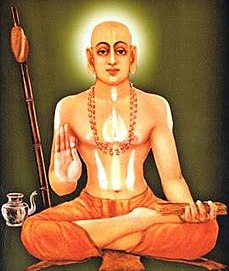Vidyadhiraja Tirtha
Vidyadhiraja Tirtha was a Hindu philosopher, dialectician and the seventh pontiff of Madhvacharya Peetha and served as peetadhipathi of Uttaradi Math from (c. 1388 – c. 1392).[3][4]
Vidyādhiraja Tīrtha | |
|---|---|
| Personal | |
| Born | Krishna Bhatt |
| Religion | Hinduism |
| Order | Vedanta (Uttaradi Math) |
| Philosophy | Dvaita Vedanta, Vaishnavism |
| Religious career | |
| Guru | Jayatirtha |
| Successor | Kavindra Tirtha (Uttaradi Math) Rajendra Tirtha (Vyasaraja Math)[1][2] |
Disciples
| |
| Part of a series on |
| Dvaita |
|---|
 |
|
Literature
|
|
|
Holy places |
| Hinduism portal |
Bifurcation of Mathas
It was during the time of Vidyadhiraja Tirtha that the first bifurcation of the Madhva Mathas took place. According to tradition Vidyadhiraja want to ordain Rajendra Tirtha, one of his disciples, to succeed him on the pontifical throne. But when Vidyadhiraja fell ill and the time came for formally handing over Matha to Rajendra Tirtha, the latter, who was on tour at the critical juncture. So Vidyadhiraja ordained his disciple Kavindra to succeed him on the pontifical throne. This selection of Kavindra Tirtha as the successor of Vidyadhiraja, leaving Rajendra Tirtha resulted in the bifurcation of the Madhva Mathas, namely Uttaradi Math presided by Kavindra Tirtha and Vyasaraya Math at Sosale headed by Rajendra Tirtha. Kavindra Tirtha was formally crowned as "Vedanta Samrat" by his Guru Vidyadhiraja Tirtha in the traditional way. The entire samsthana and all the properties of Uttarādi Matha were publicly handed over to Shri Kavindra Tirtha in a grand ceremony. Sri Uttaradi Matha is the original lineage of the Shri Madhvacharya.[5]
Works
Vidyadhiraja composed five major works they are:[5][6]
- Chāndogyābhāṣyaṭikā
- Gītā Vivruthi, a complete translation and meaning to Gita Bhashya and Gita Tatparya of Madhva.
- Viṣṇusahasranāmavivruthi, a commentary on Vishnu Sahasranama.
- Vakyārtha-candrika, a commentary on Jayatirtha's Nyāya-sudha.[7]
- Visvapadi (also known as Visvapati), a commentary on Narayana Panditacharya's Sri Madhva Vijaya.[7]
References
- Konduri Sarojini Devi (1990). Religion in Vijayanagara Empire. Sterling Publishers. p. 133.
This selection of Kavindra as the successor of Vidyadhiraja, leaving Rajendra Tirtha resulted in the bifurcation of the Madhva Mathas, namely Vyasaraya Matha at Sosale headed by Rajendra Tirtha and Uttaradi Matha presided by Kavindra Tirtha.
- Sadhu Subrahmanya Sastry; V. Vijayaraghavacharya. Tirumalai-Tirupati Dēvasthānam Epigraphical Series: pt. 1. Inscriptions of Venkatapatiraya's time. Sri Mahant's Dévasthānam Press. p. 72.
Vidyādhirāja Tirtha ( the sixth Pontiff) or sixth successor of Uttarādi Matha) and founder of Vyāsarāya Matha), and appointed Rajendra Tirtha, as first Pontiff of this Vyāsaraya Matha
- Sharma 2000, p. 451.
- Ṣādiq Naqvī; V. Kishan Rao; A. Satyanarayana (2005). A Thousand Laurels--Dr. Sadiq Naqvi: Studies on Medieval India with Special Reference to Deccan, Volume 2. Osmania University. p. 777.
Sri Vidyadhiraja Tirtha, the disciple and a worthy successor of Jaya Tirtha who occupied the throne of Vedanta Samrajya of the Uttaradi Mutt.
- Devi 1990, p. 133.
- Sharma 2000, p. 452.
- Glasenapp 1992, p. 236.
Bibliography
- Sharma, B. N. Krishnamurti (2000). A History of the Dvaita School of Vedānta and Its Literature, Vol 1. 3rd Edition. Motilal Banarsidass (2008 Reprint). ISBN 978-8120815759.CS1 maint: ref=harv (link)
- Devi, K. Sarojini (1990). Religion in Vijayanagara Empire. Sterling Publishers.CS1 maint: ref=harv (link)
- Glasenapp, Helmuth Von (1992). Madhva's Philosophy of the Viṣṇu Faith. Dvaita Vedanta Studies and Research Foundation.CS1 maint: ref=harv (link)